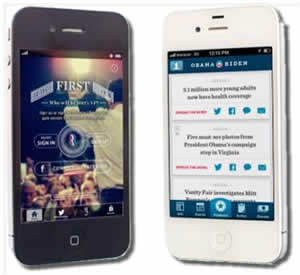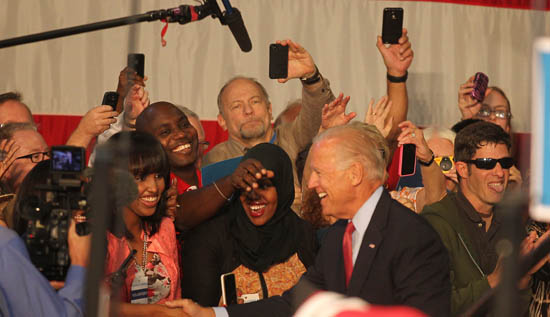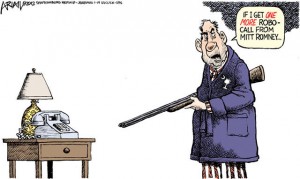Please Note: This is the first of a three-part series analyzing the full spectrum of mobile tools used by both presidential campaigns.

Now that Americans inaugurated President Obama, it’s a good time to review how both campaigns leveraged mobile tools. While nearly all campaigns lack the financial and staff of presidential races, there is much that you can gleam from their efforts that can be affordable applied to yours.
Engaging voters via mobile requires more than just creating an app or slapping a QR code on a lawn sign. Both Obama and Romney pushed the capabilities of mobile with many successes and failures to fundraise, engage and GOTV:
Mobile Web:
These two facts that should make you pause: over half of Americans use a smartphone and 28 percent use their mobile phone as their primary means of accessing the internet. Having a mobile-optimized website is no longer an option for campaigns. Mobile sites act as the hub that drives action to and from multiple channels including email, social media, SMS and even search.
Both campaigns understood this fact, but they took different design approaches: Obama’s site was mobile responsive and Romney created a separate mobile site. Each site had strengths and weaknesses for both action- and information-oriented visitors.
Obama followed the mobile-first approach—one most recommended by designers. Unfortunately, that was the end of their smart thinking. While it’s critical to ensure that mobile users have access to the same information as desktop users, you need to balance site speed with content parity and navigation or you’ll lose visitors. This is the big failure of their site. They shoe-horned all of the content from the home page into a massive single, 15,770 pixel long, 4.2MB page. It took a minimum of 30 seconds to download. This is deadly considering that over 74% of mobile users, especially those action-oriented, won’t wait more than 5 seconds for a site to load.
Team Romney created a dedicated mobile site that loaded quickly, but it did so at the expense of content. It contained a fraction of what was on the desktop sites. Mobile users also could not route to the desktop site to go deeper on a topic. Worse, the many channels the campaigned used to drive traffic to the desktop site didn’t appear on their mobile site. While both sites are filled with opportunities for action-oriented visitors, this one has a better chance of converting visitors.
Takeaways:
Since most political campaigns sites are not content heavy, it’s in your best interests to provide a separate mobile site with these three caveats:
- You don’t update your site daily. While cross-posting new content on a mobile site is just an extra step, it can add a significant amount of time as you post more.
- You have the technical competence needed internally. Thanks to easy-to-use content management systems (CMS) like WordPress, updating a site is far easier today, but you still need to have the capacity to do so.
- You treat forms differently from each version. Mobile users are less likely to fill out more than 3-4 fields. So adjust forms accordingly when you can (while following FEC regulations).
In Part 2, we will review how both campaigns leveraged mobile advertising and fundraising.
I just checked election day countdown. There’s 18 days and 22 hours left for the polls close in Minnesota. If you’re months deep into managing a campaign, you’ve already transitioned your focus from fundraising to staging for getting out the vote.
For those of us who live outside of the world politics and campaigns, we also notice the increase use of a particular and very unwelcomed interruption: those dreaded robocalls. This tool is one of the markers of a poorly run campaign.
So why do both issue and candidate campaigns use them?
- They’re cheap: After burning through millions of dollars and lawn signs, television ads and other high-priced tools, robo-calls seem like a bargain. At $.03-$.05 per call, campaigns can reach thousands of potential voters for the cost of one midmarket TV spot.
- They’re labor free: Campaign staff spend tremendous amounts of time recruiting volunteers to make phone calls to win over thousands of swing voters. Robocalls can be set up in a matter of just a few hours of staff time.
- They can leverage celebrity endorsements: The social psychology thinking goes something like this, let’s get a well-loved celebrity, like Morgan Freeman, to record the message. Since Mr. Freeman is well known and regarded, people will welcome message from him.
- They’re habit forming: Campaign managers are creatures of habit. The logic goes that robocalls were likely used in prior campaigns where they volunteered, and then staffed, and then ran on their own. The first time someone smokes a cigarette, they are unlikely to get addicted. But after that second third or fourth cancer stick, they’re more likely to become smoker.
Too many campaign managers are addicted to robocalls, and they’ve become a cancer within the industry. So why should they kicked the habit?
- They don’t work: Numerous scientific studies over the last decade have shown that robocalls contribute zero impact when used as a get out the vote (GOTV) tool.
- People screen calls: In the days before caller ID, answering the phone was a crapshoot. Today, unrecognized phone numbers rarely break through a person’s screening.
- They irritate supporters: And if campaigns have to use the recognized number counter call screening, they risk doing little more than irking the people who support them financially and volunteer their time.
- They can be illegal: If a campaign robocalls a mobile phone without prior consent, they could be hit with a $16,000 fine per instance by the FCC.
SMS is a better alternative to robocalls. An effective GOTV campaign will win any close race. Your core supporters are more likely to opt-in text messaging, especially millennial voters, because they’re less intrusive. Here’s a few ways they can use text messaging to get out the vote:
- Offer to send a reminder to vote: While presidential election cycles see greater turnout, a simple reminder on Election Day can have a great impact in primary and midterm races.
- Asking supporters to forward messages: Thankfully, forwarding a robocalls is pretty tough to do. Asking supporter to forward text message to remind their friends about registering to vote, applying for an absence a ballot or simply asked them if they voted is relatively painless. And it also comes from someone they know.
- Asking for help: The people who opt into your mobile list are more likely to be your strongest supporters. So why not ask them to volunteer? Campaigns can send out a quick message about volunteer opportunities on Election Day. It’s likely to be more efficient than having volunteers call other potential volunteers.
In time, text messaging and other mobile tools might find kick the robocall addiction. Until then, the best we can do is to screen our calls. If you’d like to do more to end the scourge of robocalls, check out this great program from the Citizens for Civil Discourse.

“Pull Out Your Phones, Please.”
I just got back from the Vice President Biden rally in downtown Minneapolis. There were the ample cheers, community praises and campaign promises that you’d expect at these types of events. The shift happened when Minneapolis Mayor RT Rybak asked the crowd:
“Pull out your phones please. Let me see them in the air. Now text MN to 62262 so that we can let you know what’s happening.”
This is the first time that I heard anyone make this type of call-to-action in this election cycle (besides our clients). In 2008, the Obama campaign used SMS to great extent. The campaign first flashed an opt-in message during their Super Bowl ad in 2008, and added nearly 750,000 to their list within minutes. Through Election Day 2012, it was hard to miss that opt in message: Text HOPE to 62262.
And in 2012: nothing. To sign up for Obama’s was SMS list, you need to go to their homepage, scroll down to the bottom and click on SMS. That’s certainly not the best approach for building your SMS list.
Romney’s campaign isn’t doing much better. I had to do a few Google searches to discover that the campaign buried its opt-in message to the bottom of its privacy statement page: http://www.mittromney.com/privacy.
With the advent of other mobile tools, such as apps, both presidential campaigns have pushed SMS to the back seat. While other tools might be flashy, there simply is no more effective mobile tool at engaging and empowering supporters than SMS, especially when reaching communities of color and younger voters.
It’s in the best interest of both campaigns to reconsider their SMS use.
(Photo Credit: Jerry Holt, Star Tribune)

Has Romney Updated a 2008 Obama Tactic?
If there’s one thing in the presidential campaign that can grab attention, it’s a running mate announcement. Four years ago, Obama sent nearly 3,000,000 people this text message at approximately 3:09AM EST:
Barack has chosen Senator Joe Biden to be our VP nominee. Watch the first Obama-Biden rally live at 3 PM Eastern time on www.BarackObama.com. Spread the word!
While there were a lot of finger-pointing for that early wake-up text and some in the media called it earlier, the campaign effectively used the carrot of the VP announcement to build up their SMS list.
Well, it seems someone in the Romney campaign paid attention. The campaign sent out this text message at 8:17AM EST this morning:
Who will be Mitt’s VP? Download the app and you’ll be the first to find out: http://mi.tt/QR50iY
While this message hit our West Coast SMS trackers at 5:17 AM (Mormons must not sleep in), we thought this is a great update, overall. Here are some takeaways:
- If your campaign is large enough to create an app, look for creative ways like this to drive downloads.
- But developing a single function app, like Mitt’s VP, is a bad idea. It’s a waste of resources and inertia–better to send them to the main campaign app.
- Less is more. Obama use 158 characters in his message. Romney use 96. While the messages have different intents, use words wisely to maximize impact.
- A personalized URL shortener, like http://mi.tt, is fantastic. Just make sure that it contains actual words and not an alphanumeric code. We typed in the wrong address and were bounced to a cute bit.ly error page. That kills word-of-mouth.
- And by all means, invite us to forward the text message. According to PEW, 10% of adults they surveyed said text messages to friends and family in the 2010 midterms. That’s a ton of people even on a statewide race.
What are your thoughts on this text?

When this image popped into my team’s email and Facebook timelines, our immediate responses ranged from jaws dropping to light vulgarity. This perplexing image did little more than distracted us, especially considering the organization that sent it.
The group that sent this was not the Humane Society, nor do they have anything to do with animal rights.
There’s a common theory that if you use cute pets you can sell anything.
When it comes to politics, I’m not humorless, but on this matter I flatly disagree:
- There’s a place for cuteness and humor in politics, such as photo ops with candidates and events, not crappy overused stock photography of kittens.
- People are easily distracted, and there’s a lot of noise in campaign season. Every effort needs to be on message and drive users to action.
- When you’re dealing with an issue that impacts the quality of life of many, ask yourself if you really need to be cute or funny. What’s to gain from taking a direction?
And if you still need to soften a message, use imagery that reinforces why your campaign is important and who impacts, not LOLcats.
Besides choice of image, here’s where this attempt falls flat:
- The campaign needed to add what to expect from the list. And the key statement “Msg. & Info rates may apply.” Failure to do so could lead to suspended accounts or worse with your mobile provider.
- Not only the copy, but images need to be MMA compliant, for they can quickly find its way onto Pinterest or Facebook images without the copy attached.
- They included their Facebook URL. If the primary goal is to get them to sign up for SMS updates, don’t distract them with another call to action even if it’s passive.
Images and emotions matter in campaigns, and they’re also tied together. Be sure to use them wisely.





